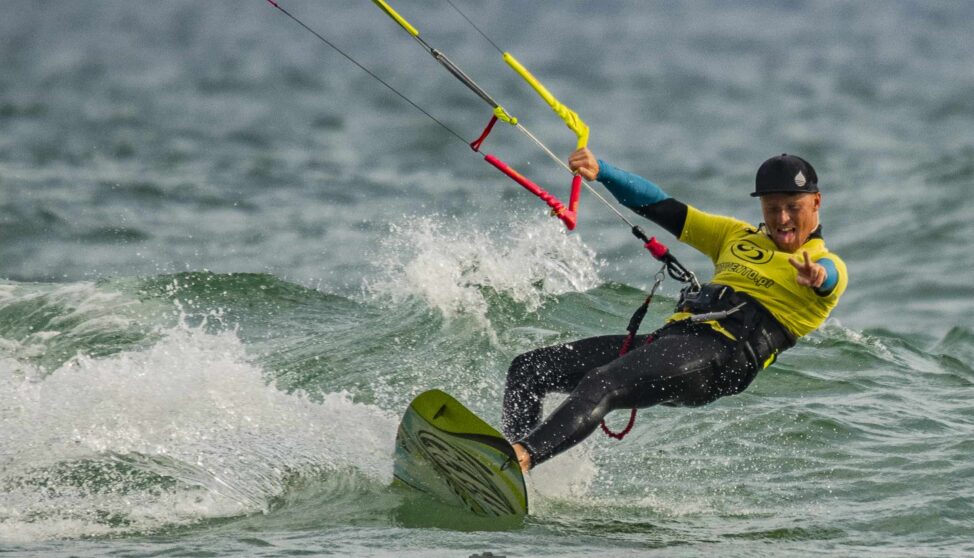kiteSurf School
Costa da Caparica

Kitesurf School
KATAVENTO is a Kitesurf school with 25 years of experience, driven by passion. Enjoying what we do is part of our philosophy.
We have only one mission: to offer our clients unforgettable lessons, whether it's KiteSurfing or Stand Up Paddle Surfing!
Our Kitesurf school is located just 20 minutes from the capital of Lisbon.
Visit us at costa da caparica, praia da Bela Vista and spend a wonderful day with us !
We have a vast experience in teaching these modalities. Kitesurf classes are taught only by coaches certified by the F. Portuguesa de Vela, F. Francesa de Vôo livre or by the IO (International Organization).
We offer a wide range of Kitesurf, SUP and WingFoil equipment for both beginners and experts.
Don't waste any more time, come meet us!
We are 20 minutes from Lisbon, located on the Coast of Caparica, the best spot to do either Kitesurf, WingFoil or Paddlesurf.
If you have any questions do not hesitate to contact us, see you in the water.
If you already kitesurf but don't have that confidence yet, Costa da Caparica is the ideal place
We have a vast sandy beach, predominant Nw wind (side-on) which provides ideal conditions for both Kitesurfing and Wingfoil.
We have been pioneers in these activities and can recommend the most suitable equipment for your level, be it Kitesurfing, Paddlesurfing or WingFoil, so that you can enjoy any of these activities in the safest and fastest way.
Considerations to Have When Choosing a Kitesurf School
Qualified Instructors
Check if the school has qualified and certified instructors. They should have solid experience in kitesurfing, knowledge of best safety practices, and effective teaching skills.
Safety
Safety is an absolute priority when practicing kitesurfing. Make sure the school has clear safety procedures, provides quality equipment, and maintains a safe learning environment.
Structured Lessons
Check if the school offers structured and progressive lessons suited to your skill level. This includes learning about wind conditions, kite flying techniques, equipment setup and breakdown, right-of-way rules on the water, and basic maneuvers.
Student-Instructor Ratio
The quality of student-instructor interaction is crucial for an effective learning experience. Ensure that the school maintains an appropriate instructor-to-student ratio to guarantee personalized attention and proper feedback.
Equipment and Facilities
Make sure the school provides quality equipment in good condition. It’s important to have access to a variety of kite and board sizes suited to the wind conditions and your skill level. Also, check if the school has proper facilities such as changing rooms, gear storage areas, and teaching areas.
Reviews and Reputation
Research the reputation of the kitesurf school. Check reviews and testimonials from previous students to get an idea of the quality of instruction and student satisfaction.
Location and Wind Conditions
Consider the school's location in relation to favorable wind conditions for kitesurfing. Ensure the school is located in an area with consistent and safe winds for practicing the sport.
Price and Packages
Consider the cost of lessons and the packages offered by the school. Compare prices and check what’s included, such as equipment rental, learning materials, insurance, and more.
Kite (Sail/Wing)
What is the Kite?
Also known as a sail or kitesurf wing.
It is an aerodynamic device that captures the wind's power and generates the traction needed to propel the rider across the water.
Kite Structure
The kitesurf kite is typically built with a flexible frame made of segmented tubes to provide rigidity and aerodynamic stability.
The structure is inflatable, with air bladders that are filled to give the kite its shape.
Panels
The kite is covered by panels made of strong material such as polyester or nylon fabric, sewn together to form the kite's surface.
Lines
The kite is connected to the rider via strong and durable lines, usually made of Dyneema or Spectra, which have high tensile strength.
The lines are attached to a control bar, allowing the rider to control the kite’s direction and power.
Bridles
The kite may have a bridle system (additional lines) that controls the kite’s shape and stability.
These lines are attached to the kite's structure and help distribute the load properly during flight.
Sizes and Shapes
Kites come in a variety of sizes and shapes, designed to adapt to different wind conditions and riding styles.
Smaller kites are used in stronger winds, while larger kites are suitable for lighter winds
KiteSurf Course
Structure
The Kitesurf Course is structured to teach you how to practice the sport independently and safely.
Equipment and Ground Control
This stage includes an introduction to the equipment and how to set it up.
Once all safety checks are completed, you begin to control the kite, discovering the neutral and power zones, and learning to launch and land it safely.
At the end of this stage, you will be able to control the kite on land.
Observation
In the initial phase, you learn to observe the sea, the wind effects, and the surrounding area.
Entering the water
Next, you enter the water and practice the Body Drag technique, which involves moving without a board, using the kite and your body to maintain balance.
This phase is extremely important as the technique is essential for recovering the board when it drifts away.
Controlling the Kite and Board in Water
In the third stage, you perform various exercises to gain control of the kite and board in the water, with and without waves.
You’ll be introduced to the Water Start, which consists of balancing your body with the power of the kite, with the board on your feet, and attempting your first rides.
Certificate
At the end of the kitesurf course, the instructor will issue a certificate indicating the level you have reached. This card works like a driver's license and allows you to rent equipment at any Kite Center if you don’t have your own.
